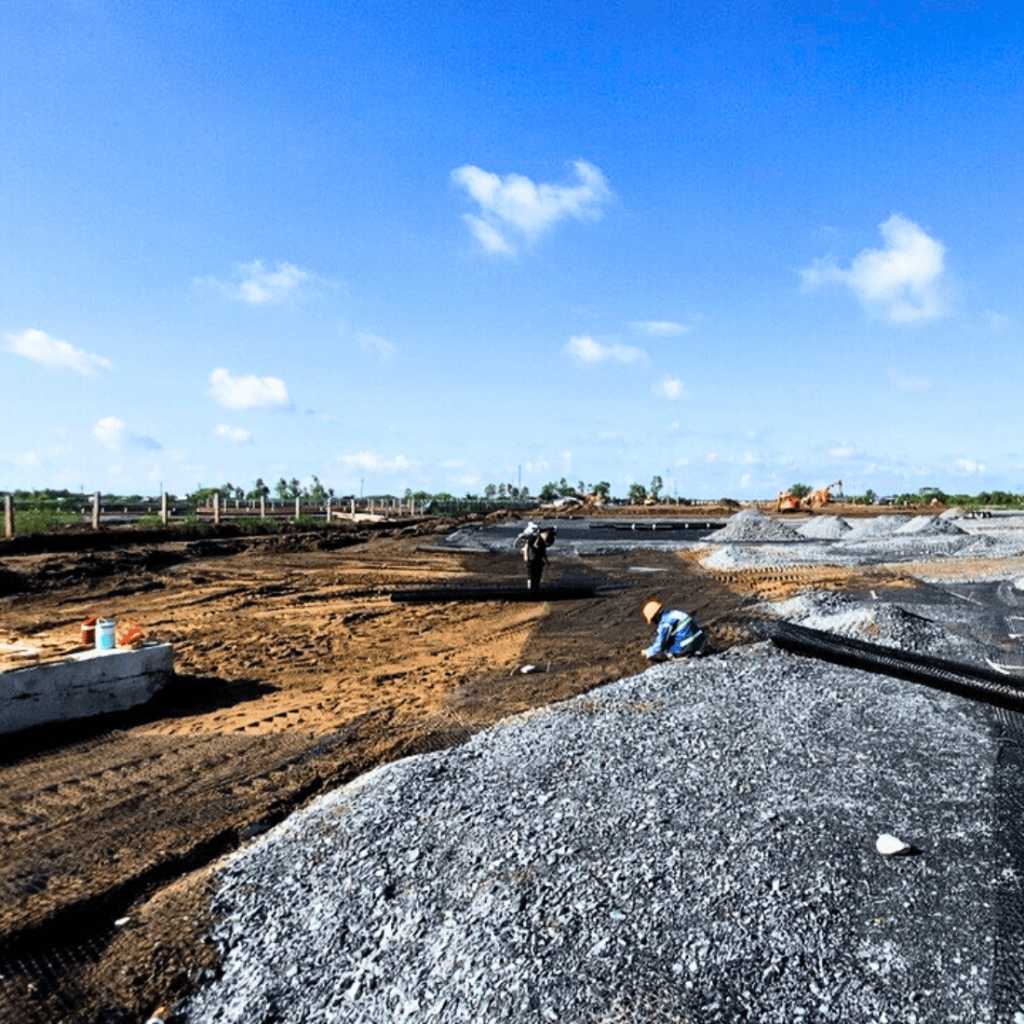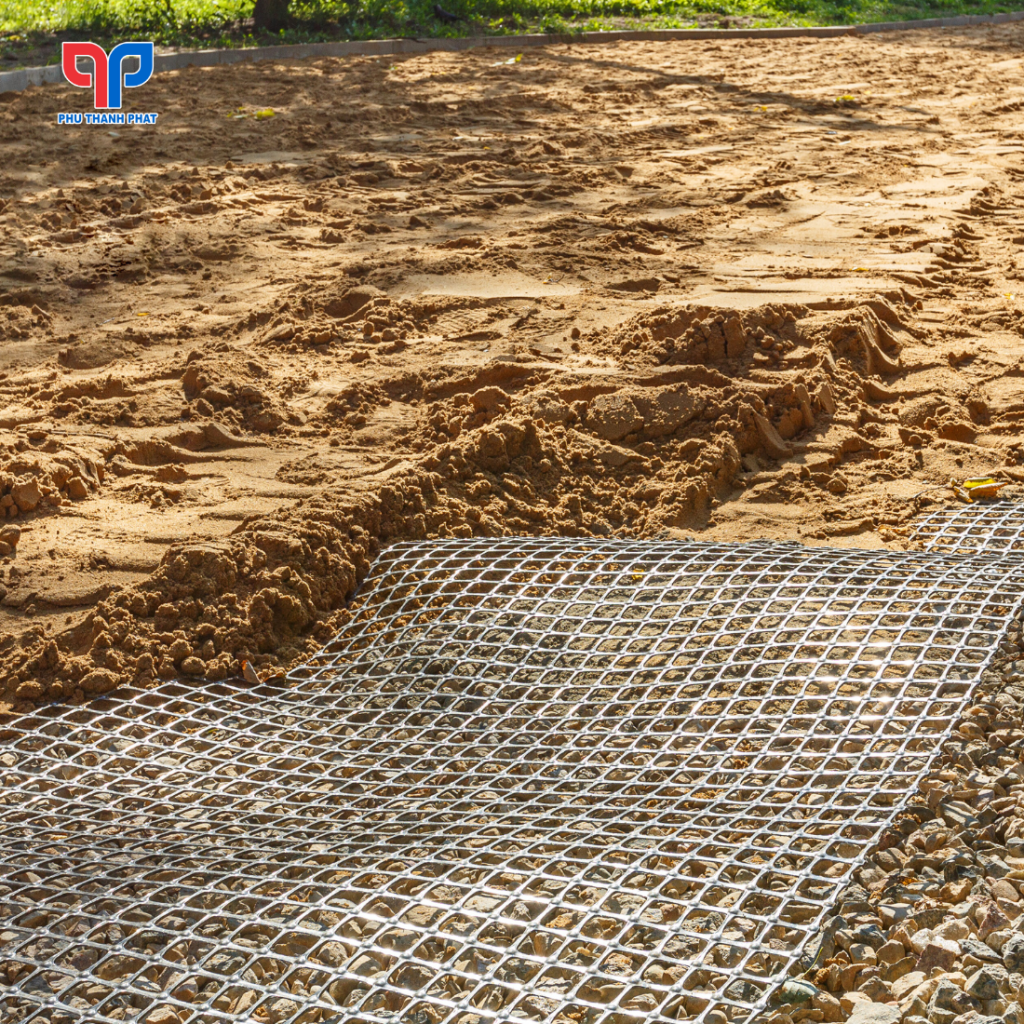Reinforcing soft soil with geogrids is an effective and widely adopted ground improvement technique. It delivers high application efficiency and stress distribution. So, why do geogrids offer such significant advantages and benefits? What are the primary application areas for these materials? Let’s explore this topic with Phu Thanh Phat!
Why Use Geogrids as a Soft Soil Reinforcement Solution?
Geogrids are a type of geosynthetic material commonly utilized in projects requiring stabilization and reinforcement of weak soils or structures subjected to high loads. Constructed from high-tensile strength synthetic polymer fibers with excellent load-bearing capacity and low deformation characteristics, geogrids are considered an optimal solution for these types of projects due to several fundamental reasons:
Geogrids Enhance the Bearing Capacity of Soil
- Load Distribution: The grid structure of geogrids helps to distribute applied stresses over a larger area, minimizing pressure on weaker zones within the soil mass.
- Increased Internal Friction: The geogrid ribs interlock with the soil particles, enhancing the frictional interaction between them. This leads to a more cohesive soil mass, increasing the stiffness and stability of the foundation soil.
Preventing Settlement and Erosion
- Protective Layer Formation: The open grid structure of geogrids effectively confines soil particles within its apertures. This significantly prevents soil erosion, settlement, and slope instability (landslides).
- Slope Stabilization: Geogrids are effectively used to reinforce soil slopes and embankments, preventing slope failure and ensuring the long-term stability of engineered slopes.
Geogrid Applications Offer Cost and Time Savings
- Reduced Fill Material Volume: Geogrids can significantly reduce the required volume of fill material, leading to substantial cost savings on material procurement and transportation while maintaining optimal reinforcement performance.
- Accelerated Construction Schedule: The installation process for geogrids is straightforward and rapid, often not requiring heavy construction equipment. This contributes to significant time and labor cost savings.
Geogrids Offer High Flexibility and Durability
- Versatile Applications: Geogrids can be implemented in a wide range of civil engineering projects, from residential and commercial developments to transportation infrastructure and gravity-retaining structures such as mechanically stabilized earth (MSE) walls and gravity walls. They are also adaptable to various terrains, including uneven surfaces like hillsides and foothills.
- Long-Term Performance: Manufactured from durable synthetic polymer fibers with high tensile strength, geogrids exhibit excellent resistance to environmental degradation and natural conditions. This ensures a long-lasting structural integrity for the project, reducing maintenance, repair costs, and guaranteeing optimal operational performance over an extended service life.


Key Applications of Geogrids for Soft Soil Reinforcement and Stabilization
- Stabilizing foundations, reinforcing weak soils, enhancing bearing capacity, preventing and minimizing cracking, and extending the service life of transportation infrastructure projects such as roadways, highways, airports, container ports, etc.
- Reinforcing slopes, preventing landslides and instability of road embankments, bridge approach fills, and structures on slopes and embankments.
- Pile Cap Reinforcement: After pile driving, geogrids are laid over the pile heads, creating a load transfer platform that efficiently distributes the superstructure load to all piles. This can also lead to a reduction in the number of piles required.
- Creating support meshes over areas with voids in the subgrade.


Conclusion
Geogrids are primarily utilized in projects requiring reinforcement and stabilization of soft soils, embankments on soft ground, slopes, and retaining structures. With their numerous advantages and effective reinforcement capabilities, geogrids are an indispensable material in geotechnical engineering. For optimal geogrid solutions tailored to your project, please leave your contact information or contact Phu Thanh Phat directly. We will provide prompt consultation and address your inquiries as soon as we receive your information!
CONTACT INFORMATION
Head Office: 15 Street 5, Vinh Loc Residential Area, Binh Hung Hoa B Ward, Binh Tan District, Ho Chi Minh City
Hotline: 028.666.03482 – 0909.452.039 – 0903.877.809
Email: info@vaidiakythuat.com
